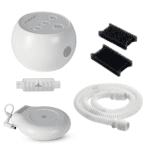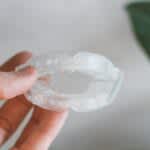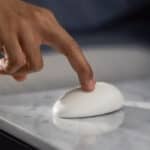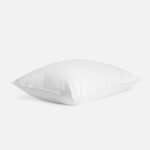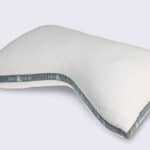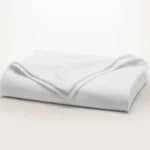Foam is a highly versatile material that modern mattress manufacturers use to provide comfort and support. Certain formulations are plush and pressure relieving, while others are firm and strong. The difference in performance is largely related to a foam’s type and density.
Foam density refers to how compact a foam’s cells are relative to its volume. Density is measured in pounds per cubic foot (PCF), which is determined by dividing weight by volume. For example, a piece of foam that weighs 100 pounds and measures 20 cubic feet has a density of 5 PCF. Foam with a high PCF is heavy because its cells are densely packed together.
This simple measurement offers a wealth of information that can help you better understand a particular foam’s firmness and durability, as well as its ability to relieve pressure. Most companies layer different foam types and densities to create various effects. When choosing the best mattress for you, it’s important to consider each layer’s density to fully understand how a bed will feel.
We’ll explore average density among foam types and discuss the differences between memory foam and polyfoam. In addition, we’ll explain how density affects mattress performance and help you determine what to look for when choosing your own mattress.
Densities of Different Types of Foam
Manufacturers often use memory foam and polyfoam as part of their mattress designs. These two foams have different additives and internal structures that cause variations in their densities.
The cells in memory foam are densely packed, while polyfoam cells are farther apart. This means that even low-density memory foam still has a higher PCF than high-density polyfoam. When you’re comparing foam options, be sure to look at both the type of foam (memory foam or polyfoam) and the foam rating (low density, medium density, or high density) to get a better picture of how the mattress will perform.
High-density foams tend to be more expensive than medium- and low-density foams because you get more foam per cubic foot. This also leads to increased durability and responsiveness. In contrast, low-density foams sink easily when you apply weight, conforming to your body’s shape and relieving pressure in the process. Mattress manufacturers take advantage of these properties by layering foams with varying densities. That way, you can opt for a mattress that’s both comfortable and durable.
It’s also important to note that low-, medium-, and high-density PCF ranges will vary by type of foam. For example, a low-density memory foam may have a higher PCF than a low-density polyfoam.
Foam Density | Memory Foam | Polyfoam |
|---|---|---|
Low-Density | Less than 3 PCF | Less than 1.5 PCF |
Medium-Density | 3 to 5 PCF | 1.5 to 1.7 PCF |
High-Density | More than 5 PCF | More than 1.7 PCF |
Let Us Help You Find the Perfect Bed
Answer a few questions to find the right mattress for your unique needs
What Does Foam Density Mean?
Knowing a foam’s PCF is certainly helpful, but just looking at the number won’t necessarily help you understand how density relates to feel. Generally, high-density foam feels the firmest because it requires the most pressure to compress. Comparatively, low-density foam feels plush and soft because it sinks under much less force.
When you lie on memory foam, it absorbs your body’s impact. As you get up, the foam slowly recovers its shape, leaving a “memory” of your body’s imprint behind for a few seconds. This is why memory foam is also called viscoelastic foam – because it has added viscosity and elasticity, meaning it’s thick and can resume its shape after being put under pressure. High-density memory foam can withstand the most pressure, and it takes the longest to regain its shape.
Memory foam can be beneficial or unsupportive, depending on its density and where it’s located within a mattress’s construction. Manufacturers most often use memory foam in a mattress’ comfort system rather than its support core. A plush memory foam support core wouldn’t withstand pressure well enough to keep your spine evenly aligned, though it’s very effective at relieving pressure when used in a mattress’ comfort system.
Support cores made from high-density polyfoam are firm and strong enough to support your body without allowing excessive sinkage. Medium-density foams have a balanced feel that’s suitable for use in both transitional and comfort layers.
How Foam Density Affects the Layers of Your Mattress
Foam mattresses vary by manufacturer, but most of them contain between two and five layers. Using multiple layers allows companies to create varying feels and firmness levels without compromising support. Because low-density foams compress more easily under less weight, they’re usually featured near a mattress’ top layer.
Low-density polyfoam and memory foam contour closely to your body, cradling your joints and evenly dispersing your weight. Not only does low-density foam feel plush and comfortable, it also prevents pressure points from building up, since the foam cushions your body and absorbs impact.
Medium-density foams are most often used in transitional layers because they relieve pressure while also preventing your body from sinking. This is particularly common in firm mattresses.
High-density polyfoams are usually reserved for the support core because they’re firm enough to keep your spine on an even plane while you sleep.
How Foam Density Affects Your Mattress Performance
Foam density has four major impacts on a mattress’ performance: pressure relief, temperature neutrality, durability, and weight. However, one foam layer doesn’t dictate a mattress’ entire performance all by itself. Instead, the layers work together to complement one another as part of the comfort system.
Foam Density | Memory Foam |
|---|---|
Conforming and Pressure Relief | Low-density foam conforms closely to your body, cushioning and cradling to prevent discomfort at pressure points. Sleepers who want pressure relief with more structure may prefer medium-density foam. High-density foam generally doesn’t alleviate pressure well because it requires more weight to compress, so it doesn’t provide the same “hugging” feeling. |
Temperature Neutrality | The higher a foam’s density, the fewer channels it has for air to circulate, resulting in less heat buildup. Low-density and open-cell foams are the best option for hot sleepers and people who live in warm climates. |
Weight | High-density foams weigh more than their medium- and low-density counterparts because there’s more mass present within the same amount of volume. |
Does Foam Density Affect the Firmness of Your Mattress?
Foam density can affect mattress firmness, but there are many layers to consider. We measure mattress firmness on a somewhat subjective scale that ranges from 1 to 10 and takes the whole mattress construction into consideration, rather than just one layer. Conversely, foam density is an objective mathematical equation that results in a measurement related to a single part of the mattress.
A mattress may have multiple low-density foam layers within its design, but that doesn’t necessarily mean that it feels soft. For example, it could have a firm coil support core with low-density foam on top to provide a bit of cushion. Every layer contributes to a model’s overall firmness level.
When deciding on your own mattress, you can learn a lot about a model’s durability, temperature control, and pressure relief by checking the density of its foam. However, you should also look at the mattress as a whole to decide if it’s a good fit.
Ask the Sleep Doctor
Have questions about sleep? Submit them here! We use your questions to help us decide topics for articles, videos, and newsletters. We try to answer as many questions as possible. You can also send us an email. Please note, we cannot provide specific medical advice, and always recommend you contact your doctor for any medical matters.


